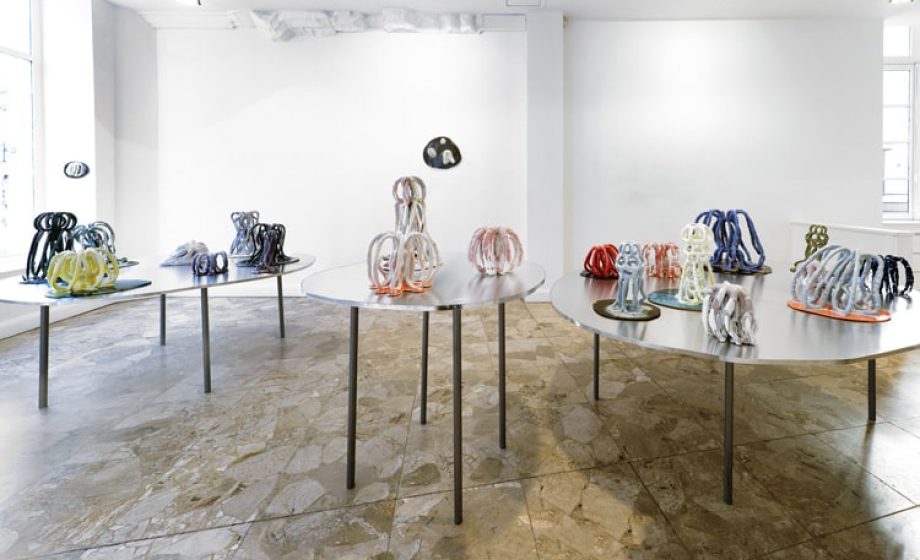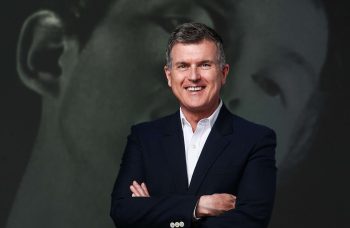Maria Lund is the director of the gallery bearing her name located on rue de Turenne in Le Marais. In an interview for Art Critique she outlines her concept of the profession of gallery owner
Orianne Castel : You cover a vast field of artistic practices, representing artists who paint as as well as those who work with glass or ceramics; how would you define your artistic vision?
Maria Lund : First of all, I’d like to clarify that, when I showcase artists who work with glass or ceramics, to me they are no different from any other visual artist. They may be people who have had training in applied arts but I choose them because they make sculpture using raw materials. They work with pottery or glass in the same way that they might have used bronze, stone or plastic. I don’t make any distinction and I’ve been struggling for almost 20 years so that an artist’s image does not depend on where he or she completed their studies but instead incorporates the reality of what they create. I noticed that this is hardly ever discussed. Even though the medium is able to accept those who are self-taught, it does not admit anyone who has training using a specific material even though their skill might completely go beyond simple technical application. I’d like to point out that the Fine Arts Academies do not hold a monopoly on the ability to think. Additionally, our gallery promotes artists who are painters or photographers. We also really like design and we exhibit video and art installations as well. We cover every medium within the field of contemporary art. As for my vision, I choose artists who have something important to say about existence, on what it means to be human in this world. That’s what interests me and I look for artists who can make a profound contribution to that subject. From an official perspective, our choices revolve as much around abstraction as they do around depiction, the narrative of physicality.
OC : You began your career by featuring Danish artists; since then you’ve developed a more global interest and now represent French, German, South-African and Korean artists as well as Americans. How and where do you discover new talent?
ML : First off, working exclusively with Danish artists in the beginning was mainly because I had an associate who was a gallery owner in Denmark at the time. In retrospect, our decision to distinguish ourselves in that way might not have been the wisest choice. Personally, I felt a bit constrained during those years. When our association ended after four and a half years, immediately I decided to open a gallery for non-Nordic artists. With respect to how I discover new artists, I often compare the process to friendly encounters; there are no rules. Every gallery receives a lot of artist applications. Personally, it’s very rare that an artist’s application interests me to the point where I want to work with them. Instead I try to connect with the pieces themselves. I try to travel often to see as many different artistic techniques as possible and I discover “bits and pieces of something” that might lead to a partnership.

OC : What kind of relationships do you maintain with your artists? Do you set limits regarding the number of artists that you can incorporate into the programming of your gallery?
ML : Certainly after 20 years we need to set limits on the number of artists we represent. It’s quite rare nowadays that I collaborate with anyone new because I’m faithful in my relationships with my artists. It’s the way that I like to work and in my opinion that’s what makes collaboration the most dynamic and the most successful for both parties and for the public. The gallery represents a record of the artist’s journey and that’s why it’s necessary to have follow-up. It’s as important for the gallery as it is for the artist, but also for the collector because we need to remember that the collector is the one who makes it all happen. Rarely does a partnership come to an end but when it does happen it can often be very painful. We invest a lot in our relationships with artists, and I’m not merely talking about the financial aspect but more in terms of personal involvement. Gallery owners and their artists get to know each other very well, we know their families, we see their children grow up and mainly we see their work evolve. I often compare my role to that of a gardener. First of all, I must select the plants with the potential for promising future growth. Then, I must water them by nurturing and supporting them. Sometimes I must also root out bad weeds with the advice I give to my artists. Certainly it’s not for me to tell an artist what to do but I reserve the right not to reject any objective that doesn’t interest me or that hasn’t successfully executed. I have the freedom to make that choice just like the artist has freedom in what they create. My relationships vary widely from one artist to another since not everyone has the same needs. Some of them are very independent all through the process right up to the exhibit. They don’t involve you until they are fairly confident about what they have created. Others need more support, they experience periods of doubt and we have encouraged them. I think that, even with the development of the Internet today, an artist’s website can’t compensate for the role that the gallery owner plays because the time spent discussing a piece is time that the artist could have devoted to their work. I think that it shouldn’t be an artist’s responsibility to try to sell their pieces. Besides they often do it very badly. So I think that right now, despite the power of the Internet, the gallery owner still performs a vital function.
OC : Your gallery is located in Marais, a district that includes many exhibition spaces; how do you set yourself apart in this landscape and build audience loyalty?
ML : I think that we set ourselves apart by our artistic vision which most often reflects a mix of the gallery owner’s personality and their more or less conscious choices. I don’t view my colleagues as competitors, I see them as people doing the same work as I do and for whom I generally have respect because it’s a difficult profession. I would say that I build audience loyalty not only through my choices but also by the attention that I give them. We are very careful about the way to welcome people who come to the gallery, whether they are clients or not. I’ve never wanted the gallery to be like a private club reserved for people who know the secret language of contemporary art. I want it to be a place that’s accessible to all and we make a real effort to welcome and to educate anyone who is not a regular gallery visitor. Everyone is welcome here.

OC : Many galleries are closing their exhibition spaces to in order to show their artists exclusively at art fairs. Has this idea ever crossed your mind? What does the site of the gallery mean to you?
ML : Yes, I’ve been disappointed to see that a good many galleries seem to be closing. That’s what happens when the market evolves. Many collectors have stopped making the rounds of the galleries because they think they’ll be able find everything worth seeing at an art fair. I compare this attitude to the metaphor of the merchant retailer and the supermarket. The supermarket requires little time commitment and can offer a wide selection but the products available for sale are not necessarily as sophisticated or as nuanced as what you might find with a retailer. Nor does the temporary nature of the art fair enable the quality of support that we can provide on a Tuesday afternoon in a gallery. Additionally, I think that trade fairs demand a presentation style that is flashier than what we can offer in a gallery with a personal exhibit that is made to last and can be visited many times. The kind of financial pressure that art fairs entail require people to make hard choices for no other reason than to reimburse costs incurred. I think that the collector who thinks that they can get a complete sense of the contemporary scene just by going to art fairs is making a mistake. So it’s disappointing to see gallery owners closing their spaces but I recognize that there is a real problem with gallery attendance. The Internet is increasingly advanced, which is good in absolute terms but it cannot compensate for the real experience of seeing a piece in all its physicality. The best photo, the best animation, the best “story” is no substitute for the reality of a piece. I’ve had the opportunity to meet people who have purchased art without ever having set foot in a gallery or institution and I admit that it makes me a bit sad.
OC : We spoke about the increasing number of art fairs, your gallery has been in existence for 20 years now, what other developments have you witnessed in your profession? How would you characterize the current art market?
ML : I’m noticing a concentration of the market in favour of major galleries with significant financial clout while medium-sized galleries who have been around for years struggle to survive. The considerable expenses and risks linked to taking part in art fairs puts a financial strain on medium-sized galleries. Previously it took about 15 to 20 years to get established, meaning to be viable, now it’s more complicated. There tremendous emphasis placed on communication means that it’s now a major part of a gallery owner’s job. We’re starting to see groups forming around a small number of artists who are shown internationally. It’s what we call the “great international circus of contemporary art”. We produce an exhibit that is shown and shut down almost at the same time in Paris, in Peking, New York or Bombay. Sometimes the art is of high quality but sometimes its like tea where you add more and more water and the taste gradually becomes diluted. It’s similar to the kind of marketing that might be found in other industries, yet I still think that works of art represent something more than just a consumer good. These days, unfortunately, art is marketed in the same way as a fashionable sweater. It’s too bad that some collectors with lots of money don’t embrace a more personal view so that the selection is wide and the quality remains high even with less prominent artists.
OC : To wrap things up, can you tell us a bit about the “Look at Me” exhibit which is being held until January 5th in your gallery?
ML : The humorous title of our current exhibit is not a display of limitless narcissism. It was chosen for two reasons. Partly it was because sculptress Bente Skjøttgaard was inspired by the comb jelly, known as the “American jellyfish”, which reflects the light when illuminated. They’re also quite beautiful creatures, very graceful and eye-catching but the title of the exhibit also refers to the fact that the comb jelly is part of what’s called the invasive species. This species originally lived near the United States but was inadvertently introduced into the Black Sea in the 1980s by fishing cargos. It began to proliferate which had the effect of reducing the fish population and consequently, fishing. So it led to both an environmental as well as a societal disaster. The title Look at Me encourages audiences to examine this problem which is yet another example of what happens when man intervenes voluntarily or unintentionally in the balance of nature. The artist was fascinated by the shape and visual appeal of this creature’s extraordinary luminosity and drew inspiration from the arrangement of the ctenophore’s incandescent combs and used it to create something spectacular. She’s an artist that I’ve been showing for 14 years now and who is considered to be one of the best ceramic sculptresses in Denmark. I enjoy following the evolution of her work which is still characterized by contact with nature and civilization. She re-explores the ceramic tradition and I’m very delighted to be showing her work once again. Her pieces have been on display many times in Korea, a country that knows a lot about ceramics, and her work has been well-received. Ours is an example of a very long partnership which is the kind I like best.






